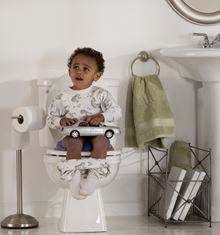Is your child constipated? How to tell and what to do about it
As a pediatric medical resident, many of my conversations with parents revolve around poop. Parents frequently have questions or concerns about their child’s stooling habits, so part of my job is letting them know what is normal and what isn’t and what they can do to help if their child is constipated. Here are a few things every parent should know about constipation in kids.
What is constipation?
Constipation is a problem in which the child passes hard, very large, infrequent or uncomfortable stools. Normal frequency of stooling in children varies. The average rate of stooling for infants is 3-4 times a day but can be as few as every 5 days. Toddlers have average rate of stooling at 2-3 times a day, but can stool every 3 days and be normal. If your child’s stooling rate is on the low end but having soft stools without pain, this is likely normal.
Symptoms of constipation include having hard stools, stools in small balls, stools that cause pain, stomach pain, nausea, 2 or fewer stools a week, stools that clog the toilet, accidents with liquid stools, or looks like they’re trying to hold in stools. If you notice these things, then it is important to discuss them with your pediatrician.
What causes constipation?
 The most common triggers of constipation are transitioning to solid foods from breastmilk and formula, potty training, and starting school. Starting solid foods can lead to reduced fiber and fluid intake causing harder stools. Children may start to withhold stools when they start potty training or going to school. They may be scared to use the toilet itself or scared to use the toilet at school.
The most common triggers of constipation are transitioning to solid foods from breastmilk and formula, potty training, and starting school. Starting solid foods can lead to reduced fiber and fluid intake causing harder stools. Children may start to withhold stools when they start potty training or going to school. They may be scared to use the toilet itself or scared to use the toilet at school.
Withholding can lead to harder stools as well as larger stools. As children keep in a stool, it gets harder and builds up making it larger. These stools hurt to pass and can cause your child to try to withhold more because they learn that it hurts to poop. This causes a vicious cycle that will require treatment to break. When a child tries to withhold, they may cross their legs, make faces, clench their buttocks, or look like they’re straining.
Other causes include illness or general changes in the child’s life or routine. Sometimes when a child gets sick they don’t eat or drink as much, and this can trigger constipation. The same can happen with a big life change like moving or a simple change like taking a weekend trip.
How do we prevent constipation?
The key to preventing constipation is to ensure adequate fluid and fiber intake at the trigger times. Maintaining good fluid and fiber intake will help keep stools soft and easy to pass. Ideally, infants and toddlers under the age of 2 years should get 5 grams of fiber daily. Children older than two years should get 5 grams of fiber plus their age in years. So, a 4-year-old should receive 9 grams of fiber a day (5 + 4 = 9g). High fiber foods to try include fruits, vegetables and fiber containing cereals.
It is important to make sure your child drinks plenty of fluids to prevent constipation. However, making sure not to go overboard on milk is important too. Cow’s milk can slow down the bowels, which gives stool a longer amount of time to harden. Milk also makes kids feel full faster, so they may not get as much fiber as they need. Children over one year of age do not need more than 32 ounces of milk a day.
It is also useful to keep track of your child’s normal stooling pattern so you can recognize if it starts to change. Knowing their pattern prior to potty training and starting school can also help you keep an eye out for withholding. Setting a regular toilet routine can also help prevent withholding from happening again.
Encouraging regular physical activity can also help keep bowel movements regular as well as maintain a healthy lifestyle.
How is constipation treated?
There are several options that you can discuss with your pediatrician.
The easiest thing to do at home is to make sure they are actually having adequate fiber and fluid intake. If that doesn’t help, then increasing the fiber in their diet with extra servings of vegetables, fruits, or whole grains can be helpful. For infants over four months of age you can add two to four ounces of 100% fruit juice to their diet while they are constipated. Prune, pear, and apple juice tend to be most helpful. Juice should only be used temporarily in infants, so discuss with your pediatrician how long to give juice. If they have started solid foods, then pureed fruits can also be used.
Your child may also require medications that, though some are over the counter, the pediatrician will need to provide instructions on how to use. These medications can work to help soften stool, make the bowels move, or clean out stool. These can include things like Miralax, laxatives, and enemas. Do not use laxatives or enemas without discussing proper use with your pediatrician first.
There are times that constipation may require a hospital stay to clean out the bowels when there is just too much stool build up. Your pediatrician can discuss this with you if your child requires it. However, most of the time constipation can be managed with a good diet and basic medications. You and your pediatrician can work out a plan that works best for your child.









